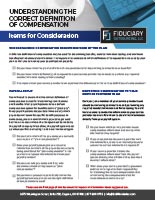
The Story
In 2013, Western Cactus Silver Mine moved recordkeepers. As part of the move, the new recordkeeper asked the payroll person to confirm that the plan was using the correct definition of compensation. The payroll person indicated that she didn’t think the 401(k) plan counted bonuses. Upon audit of the payroll records, it was determined that bonuses had been improperly ignored for determining 401(k) contribution amounts since 2005.
The Impact
All errors ended up being improperly disregarding compensation. All affected individuals had received too little money. No one had received too much money. Thankfully, no terminated employees had received a distribution in excess of what they were due.
The Correction
To correct the plan, a calculation was done to determine exactly how much money was missing from each participant’s account. This calculation was based on the missed 401(k) deferrals plus the match plus earnings. It turns out that the plan, which at the time had about $4 million in it, was missing about $85,000. It was determined that out of the 300 participants in the plan, about 45 were affected. Of the 45 affected, most were highly compensated. Since the error spanned almost ten years, it was decided to submit the plan to the IRS for correction approval.
The Result
In the end, the plan’s calculation of the amount due to participants was accepted by the IRS. The money was deposited to the plan. The user fee paid to the IRS for using the correction program was $5,000. The service provider they used to run the calculations, prepare the submission and coordinate with the IRS was an additional $7,500.
Avoiding the problem in the future
Western Cactus was concerned that this problem could happen again. What if the next payroll person misunderstood the plan’s compensation definition? After discussion with their service provider team, it was determined that none of the current service providers would provide compensation oversight for the retirement plan in a fiduciary capacity. Western Cactus decided to outsource this critical responsibility to Fiduciary Outsourcing.

The Mistake
The plan’s document defines the definition of compensation to be used to calculate contributions. The IRS has issued regulations that define what definition of compensation must be used to calculate minimum benefits and perform nondiscrimination testing. As a result, the plan may need to use different compensation for different purposes.
Compensation starts with one of three basic definitions:
- Wages subject to Internal Revenue Code Section 3401(a)
- Wages required to be reported on the Form W-2
- Wages pursuant to Internal Revenue Code Section 415
These definitions can be further modified as follows:
- Include or exclude deferrals to 401(k), 403(b), 457, 125 and HSA plans
- Include or exclude compensation earned before someone becomes eligible for the plan
- Include certain taxable fringe benefits
Compensation that fits in one of the definitions with allowable modifications above are considered safe harbor and don’t require nondiscrimination testing. However, plan sponsors can further modify their plan’s definition of compensation to add other exclusions such as bonuses, commission and / or overtime. If these further modifications are made, additional nondiscrimination testing may be required.
Often the person who sets up the payroll system is not aware of the exact definition(s) of compensation needed to run the plan properly. The payroll system gets set up with default provisions to calculate deferrals based on compensation. No further analysis is performed.
If you think about it, compensation is one of the key foundation stones of the plan. If compensation is wrong, then the contributions will be wrong. If the right contributions don’t get made, the participant will either have too much or too little money in their account. If the participant’s balance is incorrect, loans, withdrawals and distributions will be made in the incorrect amounts. In other words, if compensation isn’t correct, the plan isn’t operating properly.

If you determine that compensation is coded wrong in your payroll system, there are two parts to fixing this mistake. First, fix the payroll system for future payrolls. Second, decide how you will fix the past.
The IRS requires you to return the plan to the position it would have been in if the mistake hadn’t occurred. However, particularly as it relates to 401(k) contributions, if too little money was transmitted to the plan as employee deferrals, the employee still received the money as part of their paycheck. So, the IRS has rules that allow you to only put in 50% of the amount of the 401(k) deferral that was missed. Of course if deferrals were wrong, then the match was probably also wrong. Again, the IRS has rules about how much should be matched.
The exact rules on how to fix this error are found in IRS Revenue Procedure 2013-12. You will want to consult with a retirement plan profession who does plan corrections for assistance in determining exactly how much is due to the plan in missed contributions. You’ll also need to make up lost earnings.
If participants received too large of a contribution, the money needs to be removed from their accounts. Again, the IRS has a defined process by which this must be done. You’ll need to work with a plan corrections expert to help you navigate this process.
It is possible that during the period before you caught the mistake that terminated participants were over or under paid. It is also possible that loans were issued for more than was allowed because the account balance was incorrectly too high. Again, the IRS has provided information on how to fix all of these errors in their Revenue Procedure. If you find you have made this mistake, you should work with a plan corrections specialist to navigate your way through the maze of correction options.
If you find the error within 2 years of first making it OR if the error is considered insignificant, you can self-correct as long as you follow one of the correction methods outlined in the Revenue Procedure. However, if you find the error after 2 years and determine it’s significant, you must file with the IRS through their Voluntary Correction Program for permission to correct the plan. There is a user fee for the IRS program that varies based on the number of people in the plan.
Avoid it
There are four likely ways for a compensation mistake to occur:
- The person who sets up the payroll system doesn’t read the plan document; or
- Someone adds pay codes to the payroll system and doesn’t read the plan document; or
- Someone overrides the correctly set up payroll system; or
Whoever reports the compensation data to the service provider performing annual compliance and the nondiscrimination testing provides the incorrect payroll data.
You’ll probably notice a pattern in the list of where these errors occur. The majority of errors occur in your office in the payroll system, not in the plan’s operation. That’s concerning as often the folks in payroll are undereducated about the plan and how it works and yet they control this vital function.
One suggestion to avoid compensation errors is to provide education to your payroll person or department. Ensuring that these critical staff members understand plan compensation will go a long way to ensuring compensation is correct for the plan. The second suggestion we have is to audit your payroll system periodically. You can self-correct errors if you find them within 2 years of the time they first occurred. Auditing your payroll system at least once every two years should be considered a best practice to determine if the system is currently set up correctly and if the current staff is aware of the retirement plan’s requirements for compensation information.

How We Help
You have the ability to outsource your responsibilities as the Plan Administrator. As such, you can outsource the responsibility for auditing the payroll system to us. You can also outsource the review ofany reports or data generated to us. We then assume a fiduciary responsibility with regard to the compensation used.

Checklist
Download the items for consideration for understanding the correct definition of compensation.

The Story
In 2013, Western Cactus Silver Mine moved recordkeepers. As part of the move, the new recordkeeper asked the payroll person to confirm that the plan was using the correct definition of compensation. The payroll person indicated that she didn’t think the 401(k) plan counted bonuses. Upon audit of the payroll records, it was determined that bonuses had been improperly ignored for determining 401(k) contribution amounts since 2005.
The Impact
All errors ended up being improperly disregarding compensation. All affected individuals had received too little money. No one had received too much money. Thankfully, no terminated employees had received a distribution in excess of what they were due.
The Correction
To correct the plan, a calculation was done to determine exactly how much money was missing from each participant’s account. This calculation was based on the missed 401(k) deferrals plus the match plus earnings. It turns out that the plan, which at the time had about $4 million in it, was missing about $85,000. It was determined that out of the 300 participants in the plan, about 45 were affected. Of the 45 affected, most were highly compensated. Since the error spanned almost ten years, it was decided to submit the plan to the IRS for correction approval.
The Result
In the end, the plan’s calculation of the amount due to participants was accepted by the IRS. The money was deposited to the plan. The user fee paid to the IRS for using the correction program was $5,000. The service provider they used to run the calculations, prepare the submission and coordinate with the IRS was an additional $7,500.
Avoiding the problem in the future
Western Cactus was concerned that this problem could happen again. What if the next payroll person misunderstood the plan’s compensation definition? After discussion with their service provider team, it was determined that none of the current service providers would provide compensation oversight for the retirement plan in a fiduciary capacity. Western Cactus decided to outsource this critical responsibility to Fiduciary Outsourcing.

The Mistake
The plan’s document defines the definition of compensation to be used to calculate contributions. The IRS has issued regulations that define what definition of compensation must be used to calculate minimum benefits and perform nondiscrimination testing. As a result, the plan may need to use different compensation for different purposes.
Compensation starts with one of three basic definitions:
- Wages subject to Internal Revenue Code Section 3401(a)
- Wages required to be reported on the Form W-2
- Wages pursuant to Internal Revenue Code Section 415
These definitions can be further modified as follows:
- Include or exclude deferrals to 401(k), 403(b), 457, 125 and HSA plans
- Include or exclude compensation earned before someone becomes eligible for the plan
- Include certain taxable fringe benefits
Compensation that fits in one of the definitions with allowable modifications above are considered safe harbor and don’t require nondiscrimination testing. However, plan sponsors can further modify their plan’s definition of compensation to add other exclusions such as bonuses, commission and / or overtime. If these further modifications are made, additional nondiscrimination testing may be required.
Often the person who sets up the payroll system is not aware of the exact definition(s) of compensation needed to run the plan properly. The payroll system gets set up with default provisions to calculate deferrals based on compensation. No further analysis is performed.
If you think about it, compensation is one of the key foundation stones of the plan. If compensation is wrong, then the contributions will be wrong. If the right contributions don’t get made, the participant will either have too much or too little money in their account. If the participant’s balance is incorrect, loans, withdrawals and distributions will be made in the incorrect amounts. In other words, if compensation isn’t correct, the plan isn’t operating properly.

If you determine that compensation is coded wrong in your payroll system, there are two parts to fixing this mistake. First, fix the payroll system for future payrolls. Second, decide how you will fix the past.
The IRS requires you to return the plan to the position it would have been in if the mistake hadn’t occurred. However, particularly as it relates to 401(k) contributions, if too little money was transmitted to the plan as employee deferrals, the employee still received the money as part of their paycheck. So, the IRS has rules that allow you to only put in 50% of the amount of the 401(k) deferral that was missed. Of course if deferrals were wrong, then the match was probably also wrong. Again, the IRS has rules about how much should be matched.
The exact rules on how to fix this error are found in IRS Revenue Procedure 2013-12. You will want to consult with a retirement plan profession who does plan corrections for assistance in determining exactly how much is due to the plan in missed contributions. You’ll also need to make up lost earnings.
If participants received too large of a contribution, the money needs to be removed from their accounts. Again, the IRS has a defined process by which this must be done. You’ll need to work with a plan corrections expert to help you navigate this process.
It is possible that during the period before you caught the mistake that terminated participants were over or under paid. It is also possible that loans were issued for more than was allowed because the account balance was incorrectly too high. Again, the IRS has provided information on how to fix all of these errors in their Revenue Procedure. If you find you have made this mistake, you should work with a plan corrections specialist to navigate your way through the maze of correction options.
If you find the error within 2 years of first making it OR if the error is considered insignificant, you can self-correct as long as you follow one of the correction methods outlined in the Revenue Procedure. However, if you find the error after 2 years and determine it’s significant, you must file with the IRS through their Voluntary Correction Program for permission to correct the plan. There is a user fee for the IRS program that varies based on the number of people in the plan.
Avoid it
There are four likely ways for a compensation mistake to occur:
- The person who sets up the payroll system doesn’t read the plan document; or
- Someone adds pay codes to the payroll system and doesn’t read the plan document; or
- Someone overrides the correctly set up payroll system; or
Whoever reports the compensation data to the service provider performing annual compliance and the nondiscrimination testing provides the incorrect payroll data.
You’ll probably notice a pattern in the list of where these errors occur. The majority of errors occur in your office in the payroll system, not in the plan’s operation. That’s concerning as often the folks in payroll are undereducated about the plan and how it works and yet they control this vital function.
One suggestion to avoid compensation errors is to provide education to your payroll person or department. Ensuring that these critical staff members understand plan compensation will go a long way to ensuring compensation is correct for the plan. The second suggestion we have is to audit your payroll system periodically. You can self-correct errors if you find them within 2 years of the time they first occurred. Auditing your payroll system at least once every two years should be considered a best practice to determine if the system is currently set up correctly and if the current staff is aware of the retirement plan’s requirements for compensation information.

How We Help
You have the ability to outsource your responsibilities as the Plan Administrator. As such, you can outsource the responsibility for auditing the payroll system to us. You can also outsource the review ofany reports or data generated to us. We then assume a fiduciary responsibility with regard to the compensation used.

Checklist
Download the items for consideration for understanding the correct definition of compensation.
